
| Home | Deepsky Atlas | TheAstronews | Links | Solar System | ||||||

Hawaiian Astronomical SocietyConstellations: Ophiuchus -- A Healer too Good at his Craft |
||||||||||
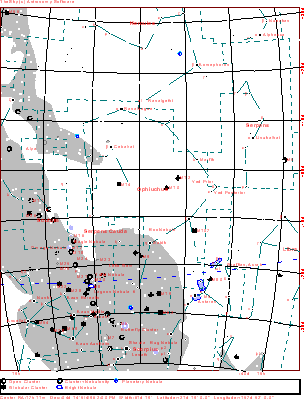
Click the map for a 916x1200 version of the above. Click here for a map better suited for use in the field.
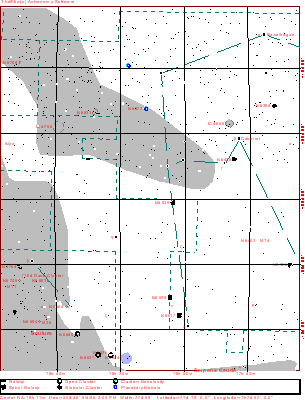
This a more detailed view of the constellation. The map displays stars to magnitude 10, and deepsky objects to magnitude 12. Click here for a map better suited for use in the field.
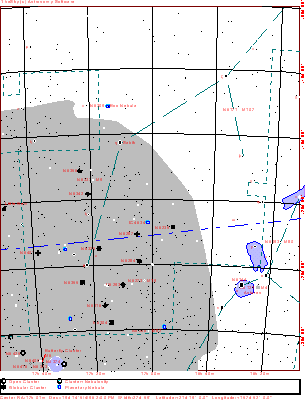
Click here for a map better suited for use in the field.
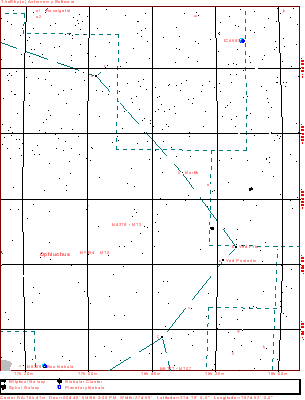
Click here for a map better suited for use in the field.
 78k JPEG NGC6633 (Best 72) is a loose open cluster (30 mag. 7 stars spread over 27') shining at mag. 4.6. 11x80mm binoculars show 12 stars in a rectangular pattern. It sits in NE Ophiuchus on the northern border of Serpens Cauda. From Le super NGC Catalogue!, although image looks like it came from the Digital Sky Survey. IC4756 sits 3° to the ESE in Serpens Cauda, making the two clusters a good binocular pair. 78k JPEG NGC6633 (Best 72) is a loose open cluster (30 mag. 7 stars spread over 27') shining at mag. 4.6. 11x80mm binoculars show 12 stars in a rectangular pattern. It sits in NE Ophiuchus on the northern border of Serpens Cauda. From Le super NGC Catalogue!, although image looks like it came from the Digital Sky Survey. IC4756 sits 3° to the ESE in Serpens Cauda, making the two clusters a good binocular pair.
|
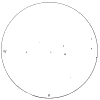 14k GIF NGC6572 (Best 71) is a planetary nebula described as very bright (mag. 9), very small (6-12", depending on scope size), round, and located in the north-east part of the constellation, 3.7° west of NGC6633, and 3° SSE of 72 Ophiuchi. 72 is the naked eye (mag. 3.8) star east and a little south of the northern "point star," Rasalhague. The central star should be fairly easy in a 10" at 200x. Observers comment on its striking green color, and recommend an OIII filter, but not a standard, narrow band filter. Image is a drawing by Jere Kahanpää. 14k GIF NGC6572 (Best 71) is a planetary nebula described as very bright (mag. 9), very small (6-12", depending on scope size), round, and located in the north-east part of the constellation, 3.7° west of NGC6633, and 3° SSE of 72 Ophiuchi. 72 is the naked eye (mag. 3.8) star east and a little south of the northern "point star," Rasalhague. The central star should be fairly easy in a 10" at 200x. Observers comment on its striking green color, and recommend an OIII filter, but not a standard, narrow band filter. Image is a drawing by Jere Kahanpää.
|
 55k JPEG IC4665 is a very large (41'), coarse open cluster located 1.3° NNE of Beta Ophiuchi. It contains 30-40 mag. 6.9 and fainter stars. This is a good object for a rich field telescope or large binoculars. Image is a mosaic of four Digital Sky Survey downloads. 55k JPEG IC4665 is a very large (41'), coarse open cluster located 1.3° NNE of Beta Ophiuchi. It contains 30-40 mag. 6.9 and fainter stars. This is a good object for a rich field telescope or large binoculars. Image is a mosaic of four Digital Sky Survey downloads.
|
 14k JPEG M14 (NGC6402, Bennett 97) is a bright (mag. 7.6), very large (12') globular cluster located 10.1° west of M10. Dreyer goes on to say it is round, and extremely rich. Image from Scott Schell's SUNY Stoney Brook Messier collection. 14k JPEG M14 (NGC6402, Bennett 97) is a bright (mag. 7.6), very large (12') globular cluster located 10.1° west of M10. Dreyer goes on to say it is round, and extremely rich. Image from Scott Schell's SUNY Stoney Brook Messier collection.
|
 82k JPEG M10 (NGC6254, Bennett 83) is a bright (mag. 6.6), very large (15'), round, globular which condenses to a packed core. A very rich cluster, one of the better ones in the sky, it is located in the rather barren central Opiuchus region located 9.6° E of Yed Posterior (Epsilon Ophiuchi). This image is from the second generation Digital Sky Survey. The original produced an image 2000 pixels wide, The larger of the two images is reduced to 1500. 82k JPEG M10 (NGC6254, Bennett 83) is a bright (mag. 6.6), very large (15'), round, globular which condenses to a packed core. A very rich cluster, one of the better ones in the sky, it is located in the rather barren central Opiuchus region located 9.6° E of Yed Posterior (Epsilon Ophiuchi). This image is from the second generation Digital Sky Survey. The original produced an image 2000 pixels wide, The larger of the two images is reduced to 1500.
|
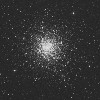 78k JPEG M12 (NGC6218, Bennett 80) is a bright (mag. 6.6) globular located 3.3° NW of M10. At 15', it is almost M10's twin, but it is more irregular in shape. Note the tiny patch of nebulosity in the lower right of the image. From the Digital Sky Survey. 78k JPEG M12 (NGC6218, Bennett 80) is a bright (mag. 6.6) globular located 3.3° NW of M10. At 15', it is almost M10's twin, but it is more irregular in shape. Note the tiny patch of nebulosity in the lower right of the image. From the Digital Sky Survey.
|
Left image is a drawing by Doug Snyder. Image on the right is an edited Digital Sky Survey download.
|
 64k Labeled JPEG The brightest (mag. 7.9) of a trio of globular clusters, M9 (NGC6333, Bennett 92) is located 3.5° SE of Sabik (Eta Ophiuchi). Its size is 9'. Dreyer calls it bright (mag. 7.9), round, extremely condensed toward the middle, and extremely rich. Don't be afraid to use higher power to resolve this one. 64k Labeled JPEG The brightest (mag. 7.9) of a trio of globular clusters, M9 (NGC6333, Bennett 92) is located 3.5° SE of Sabik (Eta Ophiuchi). Its size is 9'. Dreyer calls it bright (mag. 7.9), round, extremely condensed toward the middle, and extremely rich. Don't be afraid to use higher power to resolve this one.
NGC6356 (Bennett 93) lies 33' north-east of M9. Described as very bright (mag. 8.4), quite large (7.2'), and brightening very gradually but very much toward the middle, this is another "well resolved," cluster. It contains, Dreyer states, stars of magnitude 20. Magnitude estimates at such extremes were notoriously inaccurate in the 18th and 19th centuries. Modern estimates yield magnitude 16 stars (photographic). In practice this means the cluster looks vaguely grainy in a 12" to 13". NGC6342 is located SSE of M9. Dreyer says it is quite bright (mag. 9.9), fairly small (3'), little extended, and "easily resolvable." Steve Coe "resolved" two stars in a 13".
Image is a mosaic of six Digital Sky Survey downloads.
|
 89k JPEG NGC6304 (Bennett 90) is one of a pair of globular clusters that lies on the southern most border of Ophiuchus with Scorpius, about 3° ENE of M62.Dreyer describes the cluster as bright (mag. 8.4), quite large (6.8'), round, with little brightening toward the middle. The well resolved rating (the usual triple Rs) means that an 8" to 10" might get hints of resolution at high magnification (250x and up). Larger aperture helps. Steve Coe resolved the cluster at 135x with a 13". Dreyer states that NGC6304 contains stars of magnitude 16. More recent sources give 14.2 photographic magnitude. 89k JPEG NGC6304 (Bennett 90) is one of a pair of globular clusters that lies on the southern most border of Ophiuchus with Scorpius, about 3° ENE of M62.Dreyer describes the cluster as bright (mag. 8.4), quite large (6.8'), round, with little brightening toward the middle. The well resolved rating (the usual triple Rs) means that an 8" to 10" might get hints of resolution at high magnification (250x and up). Larger aperture helps. Steve Coe resolved the cluster at 135x with a 13". Dreyer states that NGC6304 contains stars of magnitude 16. More recent sources give 14.2 photographic magnitude.
NGC6316 (Bennett 91) lies 1.4° to the ENE. Its description reads: quite bright (mag. 9), fairly small (4.9'), round, and gradually brightening very much toward the middle. It, too is described as well resolved, with stars of magnitude 16. In spite of the similar brightness and stellar magnitude descriptions, this one is harder to resolve than its companion.
Image is a Digital Sky Survey mosaic.
|
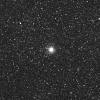 82k JPEG NGC6293 (Bennett 89) is a globular cluster that lies 3.1° WSW of Theta Ophiuchi and 11° due south of Sabik (Eta Ophiuchi). M19 lies 1.7° to the west. Dreyer describes the cluster as very bright (mag. 8.2), large (7.9'), round, with a fairly abruptly brighter middle. It is well resolved, with stars of magnitude 16. In practice, an 8" will begin to resolve it under dark skies. Image from the Digital Sky Survey. 82k JPEG NGC6293 (Bennett 89) is a globular cluster that lies 3.1° WSW of Theta Ophiuchi and 11° due south of Sabik (Eta Ophiuchi). M19 lies 1.7° to the west. Dreyer describes the cluster as very bright (mag. 8.2), large (7.9'), round, with a fairly abruptly brighter middle. It is well resolved, with stars of magnitude 16. In practice, an 8" will begin to resolve it under dark skies. Image from the Digital Sky Survey.
|
 141k JPEG Barnard 59, the western tip of the Pipe Nebula, lies just south of NGC6293. The Pipe Nebula also includes Barnard 65, 66, 67, 77, 244, and 256. This is a large structure, extending east from NGC6293 some 7°. The "bowl" of the pipe lies on the eastern end, and extends almost 3 of those degrees. Wide fields of view and dark skies are needed for this object. Image by Joe Pedit of the Chapel Hill Astronomical and Observational Society (CHAOS), 48 minute exposure on Kodak PJM-2 taken with a 35mm camera and 200mm lens, stopped down to f5.6. 141k JPEG Barnard 59, the western tip of the Pipe Nebula, lies just south of NGC6293. The Pipe Nebula also includes Barnard 65, 66, 67, 77, 244, and 256. This is a large structure, extending east from NGC6293 some 7°. The "bowl" of the pipe lies on the eastern end, and extends almost 3 of those degrees. Wide fields of view and dark skies are needed for this object. Image by Joe Pedit of the Chapel Hill Astronomical and Observational Society (CHAOS), 48 minute exposure on Kodak PJM-2 taken with a 35mm camera and 200mm lens, stopped down to f5.6.
|
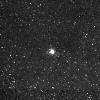 36k JPEG NGC6287 (Bennett 88) anchors a trio of globular clusters located in south-western Ophiuchus, near the border of Scorpius. It also lies 7° SSW of Sabik (Eta Ophiuchi). Described as quite bright (mag. 9.2), large (5.1'), round, and gradually brightening toward a very compressed middle, Dreyer calls it well resolved (3 Rs), containing mag. 16 stars. A 12" will just resolve the cluster. The cluster shines through the Milky Way, but surprisingly there are few foreground stars. A 4" shill show a patch of haze in a barren field. Image from the Digital Sky Survey. 36k JPEG NGC6287 (Bennett 88) anchors a trio of globular clusters located in south-western Ophiuchus, near the border of Scorpius. It also lies 7° SSW of Sabik (Eta Ophiuchi). Described as quite bright (mag. 9.2), large (5.1'), round, and gradually brightening toward a very compressed middle, Dreyer calls it well resolved (3 Rs), containing mag. 16 stars. A 12" will just resolve the cluster. The cluster shines through the Milky Way, but surprisingly there are few foreground stars. A 4" shill show a patch of haze in a barren field. Image from the Digital Sky Survey.
|
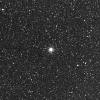 42k JPEG NGC6284 (Bennett 87) is the second in a trio of globular clusters located in south-western Ophiuchus, near the border of Scorpius. It also lies 34' NNE of M19. Described as bright (mag. 9), large (5.6'), and round with a compressed middle, Dreyer say it is well resolved (!?), with stars of magnitude 16 and fainter. An 8" will not resolve this cluster; a 12" will just resolve the edges. Image from the Digital Sky Survey. 42k JPEG NGC6284 (Bennett 87) is the second in a trio of globular clusters located in south-western Ophiuchus, near the border of Scorpius. It also lies 34' NNE of M19. Described as bright (mag. 9), large (5.6'), and round with a compressed middle, Dreyer say it is well resolved (!?), with stars of magnitude 16 and fainter. An 8" will not resolve this cluster; a 12" will just resolve the edges. Image from the Digital Sky Survey.
|
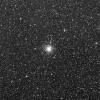 61k JPEG NGC6235 (Bennett 82) is the faintest in a trio of globular clusters located in south-western Ophiuchus, near the border of Scorpius. Described as fairly bright (mag. 10.2), quite large (5'), not quite round, and well resolved (three Dreyer Rs), it contains stars of magnitude 14 to 16. An 8" will just begin to resolve this cluster; 16" will do much better. Observers using larger instruments (12" and up) report both a "central bar" (Steve Coe) and ragged edges (Auke Slotegraaf). Image from the Digital Sky Survey. 61k JPEG NGC6235 (Bennett 82) is the faintest in a trio of globular clusters located in south-western Ophiuchus, near the border of Scorpius. Described as fairly bright (mag. 10.2), quite large (5'), not quite round, and well resolved (three Dreyer Rs), it contains stars of magnitude 14 to 16. An 8" will just begin to resolve this cluster; 16" will do much better. Observers using larger instruments (12" and up) report both a "central bar" (Steve Coe) and ragged edges (Auke Slotegraaf). Image from the Digital Sky Survey.
|
 61k JPEG M19 (NGC6273, Bennett 86) is located 7.4° east of Antares (in Scorpius). It's a globular cluster described as very bright (mag. 7.2), large (14'), round, extremely rich with a strongly condensed middle. From the second generation Digital Sky Survey. 61k JPEG M19 (NGC6273, Bennett 86) is located 7.4° east of Antares (in Scorpius). It's a globular cluster described as very bright (mag. 7.2), large (14'), round, extremely rich with a strongly condensed middle. From the second generation Digital Sky Survey.
|
 16k JPEG M62 (NGC6266, Bennett 85) is located 4.8° NNE of Epsilon Scorpii. It sits on the border of Ophiuchus and Scorpius. Dreyer describes this globular cluster as very bright (mag. 6.6), large (14'), not especially condensed for a globular, and quite easy to resolve. Some observers report M62 looks asymmetric in the eyepiece. From a one minute C-14 exposure with a HISYS22 CCD camera by Pedro Ré. 16k JPEG M62 (NGC6266, Bennett 85) is located 4.8° NNE of Epsilon Scorpii. It sits on the border of Ophiuchus and Scorpius. Dreyer describes this globular cluster as very bright (mag. 6.6), large (14'), not especially condensed for a globular, and quite easy to resolve. Some observers report M62 looks asymmetric in the eyepiece. From a one minute C-14 exposure with a HISYS22 CCD camera by Pedro Ré.
|
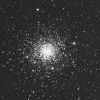 19k JPEG M107 (NGC6171, Bennett 79) is located 2.7° SSW of Zeta Ophiuchi. It sits near the border of northern Scorpius. Dreyer describes this globular cluster (mag. 6.6) as large (10'), round, very rich, very condensed, and quite easy to resolve. From the Digital Sky Survey. 19k JPEG M107 (NGC6171, Bennett 79) is located 2.7° SSW of Zeta Ophiuchi. It sits near the border of northern Scorpius. Dreyer describes this globular cluster (mag. 6.6) as large (10'), round, very rich, very condensed, and quite easy to resolve. From the Digital Sky Survey.
|
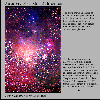 137k GIF This photo shows IC4604 as a rich area of nubulosity in Scorpius and Ophiuchus, including dark nebulae, red emission nebulae, blue reflection nebulae, and an unusual orange reflection nebula illuminated by the light from Rho Ophiuchi. Visual reality, while not so spectacular, is still striking. Here are the words of Steve Coe: "Faint, very, very large, irregular nebula with Rho OPH involved. This dim glow is best in the 10X50 binoculars. This entire system is on the edge of one of the Largest dark nebulae in the skies. About one degree away to the north-west is the area William Herschel called 'A Hole in the Heavens.' This dark nebula is so thick that a Large scope at 100X will not show one star. You must see for yourself how fascinating it is to be awash in the Milky Way one minute and in a complete void the next." 137k GIF This photo shows IC4604 as a rich area of nubulosity in Scorpius and Ophiuchus, including dark nebulae, red emission nebulae, blue reflection nebulae, and an unusual orange reflection nebula illuminated by the light from Rho Ophiuchi. Visual reality, while not so spectacular, is still striking. Here are the words of Steve Coe: "Faint, very, very large, irregular nebula with Rho OPH involved. This dim glow is best in the 10X50 binoculars. This entire system is on the edge of one of the Largest dark nebulae in the skies. About one degree away to the north-west is the area William Herschel called 'A Hole in the Heavens.' This dark nebula is so thick that a Large scope at 100X will not show one star. You must see for yourself how fascinating it is to be awash in the Milky Way one minute and in a complete void the next."
Two, twelve minute exposures on gas hypered Fujicolor Super HG 400, stacked in register, and duped on to Kodak 5072 film. The dupe was scanned and digitized, then color and contrast enhanced, and unsharp masked in Photoshop 3.0. The photo was taken by Jerry Lodriguss with a Nikon 300mm, f2.8 lens on June 1, 1995 from Massai Pt. in the Chiricahua National Monument in Arizona.
|
If you have any questions about the Hawaiian Astronomical Society
please
(link requires javascript).